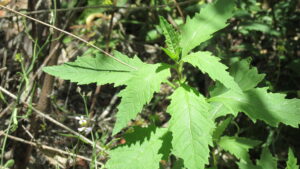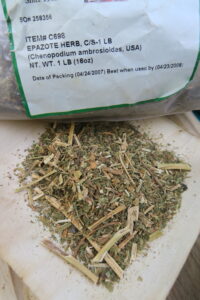EPAZOTE (Dysphania ambrosiodes) (formerly Chenopodium ambrosiodes)
Also known as Mexican tea or wormseed. Member of the Goosefoot Family
Epazote is a wonderful herb to know, which has been used in Mexican cookery for centuries. Said to originate from central Mexico, it can now be found throughout North America.
A view of the epazote plant.
DESCRIPTION
Probably the most distinctive aspect of epazote is its unique aroma – a blind man should be able to identify it! When seen for the first time, it might appear as a somewhat ragged and darker green lambs quarter (to which it’s related).
Epazote has a branched stem which can reach up to about three feet. The shiny-green leaves are elliptical, two to five inches long, and sometimes reddish tinged or blotched. The uniquely aromatic leaves are arranged alternately. The undulating leaf margin is slightly or entirely toothed. The leaf surface is hairless, although it may be slightly tomentose when very young.
WHERE FOUND
Epazote is abundant along inland stream beds in sandy soil and common in seaside salt marshes. The plant, which is sometimes cultivated, generally prefers waste locales and areas with somewhat poor, sandy soil. It seems to prefer the semi-shade along the bank of a sandy river or stream but will do well in rich garden soil when cultivated. Believed to have originated from central Mexico, it is now well naturalized throughout parts of the United States.
USES
Epazote has long been popular in Central and South American and Mexican cookery as a culinary spice, especially in bean dishes since it prevents gas. It adds a unique flavor to beans, and as an herb, it is as cherished as cilantro by some. To use, crumble dried leaves into the pot of beans, or add some fresh leaves to your particular taste.
A view of a bag of bulk dried epazote, as you’d buy from an herb supply store. Typically, the entire plant (stems and leaves) is dried, and ground up for culinary uses.
PROCESSING
Though fresh leaves can be added to dishes, the plant is usually dried first, which somewhat mellows the fragrance. The dried leaves are then crumbled into the pot of beans, or stew, shortly before being served.
ADVICE FOR GROWING
Epazote can be successfully grown from cuttings that have been rooted in good soil or vermiculite, however, most gardeners start them from seed. Soak the seeds for a few hours in water before planting, and then plant them in a flat, or directly into the garden. The seeds seem to take longer than other seeds to sprout, and gardeners often forget they even planted the seeds. So make sure to label your plantings.
Farmer Adrian Gaytan grows epazote, and sells it at local farmers markets.
WHEN TO HARVEST/ AVAILABILITY
In colder climates, epazote will live as an annual. In the South and warmer environments, it will act more as a perennial, and will come up for a few seasons.
Harvesting the mid-sized epazote plants is easy. Just pinch off the top new growth. Pinch off just what you need at the time, or pinch back a lot if you plan to dry some of the herb for storage. The leaf production of each epazote plant is greatly increased by this pinching. The entire above-ground plant will die back each year, but as long as the soil hasn’t dried out, the roots will continue to produce year after year. Also, the regular pinching-back of the leaves during the growing season will significantly extend the growing season for your plants.
A view of the maturing epazote plant. Note the red in the stems.
The leaves are best harvested young, and dried. I prefer only the leaves in my cooking. However, you will observe that in Mexico, the entire above-ground plant is harvested, dried, and ground up for use in cooking, or for sale.
MEDICINE/NUTRITION:
Epazote is most famous for its use as a way to prevent or stop excessive gas. Think of it as nature’s “Bean-O.” It is one of the best-recognized antiflatulents, also aiding the digestion. It acts as a vermifuge, expelling intestinal worms (such as roundworms and hookworms) and other intestinal parasites. It is used by the Chinese as a diaphoretic, to strengthen the eyes and the circulation, to cure coughing up blood, and for dysentery. The herb is taken either in powder form or infused into a tea.
We’ve also had positive results with using epazote to rid cats and dogs of worms. Simply sprinkle a small amount of the dried and powdered leaves into their food. Epazote seeds and leaves in chickens’ water will also cure and prevent some diseases common to fowl.
CAUTIONS
Pure oil of Chenopodium is toxic. However, epazote leaf contains only 1 percent of this oil, and such small amounts are ideal as a vermifuge or anti-flatulent. The seeds contain approximately 10 percent oil of chenopodium; a teaspoon or so of the seeds added to dog and cat food works wonders as a de-wormer and does not pose a threat to the animal’s health in such low dosage. Eating moderate amounts of the cooked greens poses no health hazard whatsoever. However, due to the strong aroma of epazote, it is rarely cooked alone. Generally, epazote greens are mixed with other greens before cooking.
WHERE TO OBTAIN
If epazote does not grow near you, the seeds are readily available from seed suppliers. One source for epazote is Survival Seeds, Post Office Box 41-834, Los Angeles, CA 90041, for $4 per seed packet (price includes postage).
RECIPES
COOKING WITH EPAZOTE
Cooking with epazote is easy! Add approx. one tablespoon of the herb — both the chopped stems and the leaves — to a pot of beans. You can use it fresh or dried. The epazote herb can also be added to soups, stews, and made into tea. The powdered leaves can be added to salads, such as potato and bean salads.
Here are some simple recipes I’ve developed for using epazote.
MAYA BLACK BEAN SOUP
1 cup black beans
sage, pinch
water
oregano, pinch
3 onions
epazote, two tsp.
3 small potatoes
salt and pepper, to taste
Cook the beans first for about an hour until tender. Then add the onions and potatoes,and cook until tender. Add the seasonings. Let simmer on low temperature for 15 minutes before serving.
LENTIL SOUP
1 cup lentils
1 bay leaf
5-6 cups water
2 tsp. dried epazote
1 diced red onion
3 cloves of garlic
2 diced carrots
Wash the lentils, and then simmer for an hour and a half. Add the other ingredients when the beans are nearly soft. Simmer `til the vegetables are soft. (Add salt or kelp to taste, if desired.)
About the Author: Christopher Nyerges
Nyerges has been teaching ethnobotany since 1974. He is the author of “Guide to Wild Foods and Useful Plants,” “Foraging Wild Edible Plants of North America,” and other books on the uses of wild plants. He can be reached at www.SchoolofSelf-Reliance.com.
Nyerges’ book, “Foraging Edible Wild Plants of North America,” contains a chapter on epazote.
PHOTOS, by Christopher Nyerges unless otherwise indicated.






